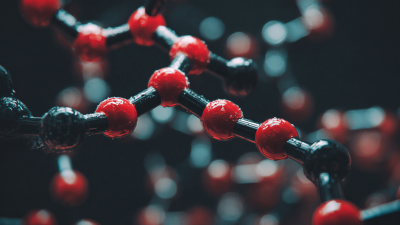Leave Your Message
In recent years, the quest for effective anticancer agents has led researchers to explore various compounds, including Anticancerogen Nitroxoline, a synthetic chelator initially used for its antibacterial properties. According to a report by the National Cancer Institute, nearly 40% of individuals will be diagnosed with cancer at some point in their lives, underscoring the urgent need for innovative therapeutic options. Recent studies have highlighted the potential of Nitroxoline not only in combating bacterial infections but also in inhibiting tumor growth and enhancing the efficacy of existing cancer therapies. In fact, research published in the Journal of Experimental Medicine indicates that Nitroxoline exhibits selective cytotoxicity against cancer cells while sparing normal cells, making it a promising candidate for multidimensional cancer treatment strategies. This blog aims to delve deep into the benefits and applications of Anticancerogen Nitroxoline, providing a comprehensive overview of its mechanisms, clinical implications, and future prospects in oncology.

Nitroxoline is emerging as a critical compound in the realm of cancer prevention and treatment. It functions primarily by inhibiting specific pathways involved in pyroptosis, a form of inflammatory cell death that can exacerbate disease progression in cancer. By disrupting the assembly of the NLRP3 inflammasome through direct interaction with the NLRP3 protein, nitroxoline effectively reduces pyroptotic cell death, which is significant in controlling inflammation associated with tumor growth.
Moreover, nitroxoline’s versatility extends beyond its anticancer properties. Recent studies have demonstrated its efficacy as a potent amoebicidal agent against pathogens like Balamuthia mandrillaris, revealing its potential for combating resistant infections. The discovery of nitroxoline derivatives, particularly ASN-1733, has shown promise as dual-functional antibiotics, effectively targeting resistant bacterial strains through unique mechanisms such as outer membrane disruption and competitive inhibition of enzymes like NDM-1. This broad spectrum of action underscores nitroxoline's growing significance in both cancer therapy and the broader context of infectious disease management, highlighting its potential as a valuable therapeutic agent in modern medicine.
Nitroxoline, a synthetic compound traditionally used as an antibiotic, is gaining recognition for its potential anticancer properties. This article presents a comprehensive overview of the key health benefits associated with Nitroxoline, highlighting its role beyond mere infection control.
One of the most significant advantages of Nitroxoline is its ability to hinder cancer cell proliferation, making it a promising candidate in oncological research. Studies suggest that Nitroxoline may induce apoptosis in cancer cells while sparing healthy tissue, a mechanism that could hold the key to innovative cancer therapies.
Moreover, Nitroxoline exhibits potent anti-inflammatory effects, which are crucial in the context of cancer as chronic inflammation is often a contributing factor to tumor development. By modulating inflammatory pathways, Nitroxoline may help create an environment less conducive to cancer progression. Additionally, its antimicrobial properties can prevent secondary infections in cancer patients, thereby improving overall treatment outcomes.
As ongoing research continues to delve into the multifaceted benefits of Nitroxoline, it presents a compelling case for its inclusion in cancer care regimens and further exploration in clinical settings.
Nitroxoline, a quinolone derivative originally developed as an antibacterial agent, has gained attention in the realm of cancer treatment and research. Its multifaceted applications extend beyond merely combating infections to acting as a potential anticancerigen. Recent studies have highlighted nitroxoline’s ability to inhibit cancer cell proliferation and induce apoptosis in various tumor types. This makes it a promising candidate for combination therapies, enhancing the efficacy of traditional chemotherapeutic agents.

In the landscape of cancer research, nitroxoline is also being explored for its role as a cheating agent that can disrupt metal ion homeostasis in malignancies. By sequestering essential metals necessary for cancer cell growth, nitroxoline may hinder the progression of tumors. Moreover, its unique mechanism of action reveals potential synergistic effects when used alongside other drugs, providing a versatile approach in addressing treatment-resistant cancers. As ongoing studies delve deeper into its applications, nitroxoline stands out as a promising compound in the fight against cancer, warranting further exploration and clinical trials to establish its full potential.
Incorporating nitroxoline into your health regimen requires a thoughtful approach to ensure safety and efficacy. First and foremost, it's crucial to consult with a healthcare professional before starting any new supplement, especially if you have pre-existing health conditions or are taking other medications. Nitroxoline, a chelating agent with anti-cancer properties, has shown potential in inhibiting tumor growth. However, understanding the right dosage and monitoring any potential side effects are essential to making it a beneficial part of your routine.
When integrating nitroxoline, consider starting with a low dose to assess tolerance. It's typically available in capsule form, and taking it with meals might enhance absorption. Additionally, pairing nitroxoline with a balanced diet rich in antioxidants can amplify its potential health benefits. Regular follow-ups with a healthcare provider will help tailor your regimen and track any improvements or adverse reactions, ensuring that nitroxoline serves as a healthy ally in your cancer defense strategy.
When considering the use of Nitroxoline as an anticancer agent, it's crucial to stay informed about its potential side effects and necessary precautions. Although Nitroxoline has shown promise in various therapeutic applications, including its anticancer properties, patients must be aware of possible adverse reactions. Common side effects include gastrointestinal disturbances such as nausea and diarrhea, as well as more severe reactions like allergic responses. Regular monitoring by healthcare professionals is essential to mitigate these risks effectively.

Moreover, patients with pre-existing medical conditions or those on other medications should exercise caution. Nitroxoline interacts with certain drugs, potentially altering their effectiveness or increasing toxicity. It is advisable for individuals to engage in thorough discussions with their healthcare provider regarding their medical history and any ongoing treatments before beginning Nitroxoline therapy. Adhering to prescribed dosages and reporting any unusual symptoms promptly can significantly enhance patient safety while benefiting from the anticancer potential of Nitroxoline.






